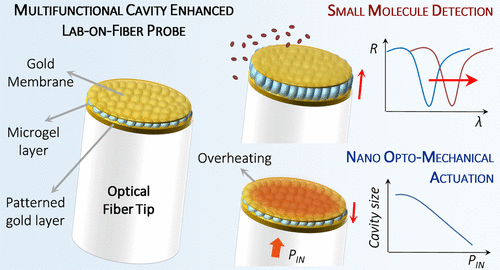当前位置:
X-MOL 学术
›
ACS Photonics
›
论文详情
Our official English website, www.x-mol.net, welcomes your
feedback! (Note: you will need to create a separate account there.)
Cavity-Enhanced Lab-on-Fiber Technology: Toward Advanced Biosensors and Nano-Opto-Mechanical Active Devices
ACS Photonics ( IF 6.5 ) Pub Date : 2019-12-05 , DOI: 10.1021/acsphotonics.9b01287 Martino Giaquinto 1 , Anna Aliberti 1 , Alberto Micco 1 , Federica Gambino 1 , Menotti Ruvo 2 , Armando Ricciardi 1 , Andrea Cusano 1
ACS Photonics ( IF 6.5 ) Pub Date : 2019-12-05 , DOI: 10.1021/acsphotonics.9b01287 Martino Giaquinto 1 , Anna Aliberti 1 , Alberto Micco 1 , Federica Gambino 1 , Menotti Ruvo 2 , Armando Ricciardi 1 , Andrea Cusano 1
Affiliation

|
The integration of nanostructures able to manipulate light at the optical fiber tip is bringing the optical fibers to a renewed dimension since their beginnings. The past decade has seen unprecedented advancements in the lab-on-fiber technology field, pushed by the effective exploitation of nanoscale optical physics and supported by the improvement of nanofabrication techniques. In this context, here we report on a cavity enhanced lab-on-fiber optrode, which dramatically boosts the performances and widens the range of applications of the current lab-on-fiber systems, setting a new fundamental milestone along the roadmap of this technology. The “lab” integrated onto the fiber tip consists of a tunable optical cavity incorporating smart materials as the active layer. Specifically, the swelling/collapsing mechanism of multiresponsive microgels sandwiched in between gold layers induces the interplay between plasmonic resonances and cavity modes, according to optical cavity size. The combination of the optically resonant effects and microgels endows the optrode with the unique ability to work as both a sensor for detecting small molecules and a nano-opto-mechanical actuator triggered by light. In the specific case study here presented, we show that the device is able to detect glucose in solution, with a sensitivity improved by more than 1 order of magnitude compared to other state-of-the-art values. Moreover, we demonstrate that, by combining thermoplasmonics effects triggered by light coupled into the fiber and the microgel thermo-responsivity, it is possible to tune and control the optical cavity features, opening new avenues toward active nano-opto-mechanical actuators directly realized onto the fiber tip.
中文翻译:

腔增强型光纤实验室技术:迈向先进的生物传感器和纳米光机械主动设备
能够操纵光纤尖端处的光的纳米结构的集成使光纤自诞生之初便具有了新的尺寸。在过去的十年中,在光纤实验室技术领域取得了空前的进步,这是由于有效利用了纳米级光学物理学,并得到了纳米加工技术的改进的支持。在此背景下,我们在此报告了一种腔增强型光纤实验室光缆,它极大地提高了性能,并扩大了当前光纤实验室系统的应用范围,为该技术的发展奠定了新的基本里程碑。集成在光纤尖端上的“实验室”由可调谐光学腔组成,该腔将智能材料用作有源层。具体来说,根据光学腔的大小,夹在金层之间的多响应微凝胶的溶胀/塌陷机制会引起等离激元共振和腔模之间的相互作用。光学共振效应和微凝胶的结合使光极具有独特的功能,既可以用作检测小分子的传感器,又可以用作光触发的纳米光机械致动器。在这里介绍的特定案例研究中,我们表明该设备能够检测溶液中的葡萄糖,与其他最新技术水平相比,其灵敏度提高了1个数量级以上。此外,我们证明,通过将耦合到光纤中的光触发的热等离子体效应与微凝胶的热响应性相结合,可以调节和控制光学腔的特性,
更新日期:2019-12-05
中文翻译:

腔增强型光纤实验室技术:迈向先进的生物传感器和纳米光机械主动设备
能够操纵光纤尖端处的光的纳米结构的集成使光纤自诞生之初便具有了新的尺寸。在过去的十年中,在光纤实验室技术领域取得了空前的进步,这是由于有效利用了纳米级光学物理学,并得到了纳米加工技术的改进的支持。在此背景下,我们在此报告了一种腔增强型光纤实验室光缆,它极大地提高了性能,并扩大了当前光纤实验室系统的应用范围,为该技术的发展奠定了新的基本里程碑。集成在光纤尖端上的“实验室”由可调谐光学腔组成,该腔将智能材料用作有源层。具体来说,根据光学腔的大小,夹在金层之间的多响应微凝胶的溶胀/塌陷机制会引起等离激元共振和腔模之间的相互作用。光学共振效应和微凝胶的结合使光极具有独特的功能,既可以用作检测小分子的传感器,又可以用作光触发的纳米光机械致动器。在这里介绍的特定案例研究中,我们表明该设备能够检测溶液中的葡萄糖,与其他最新技术水平相比,其灵敏度提高了1个数量级以上。此外,我们证明,通过将耦合到光纤中的光触发的热等离子体效应与微凝胶的热响应性相结合,可以调节和控制光学腔的特性,











































 京公网安备 11010802027423号
京公网安备 11010802027423号